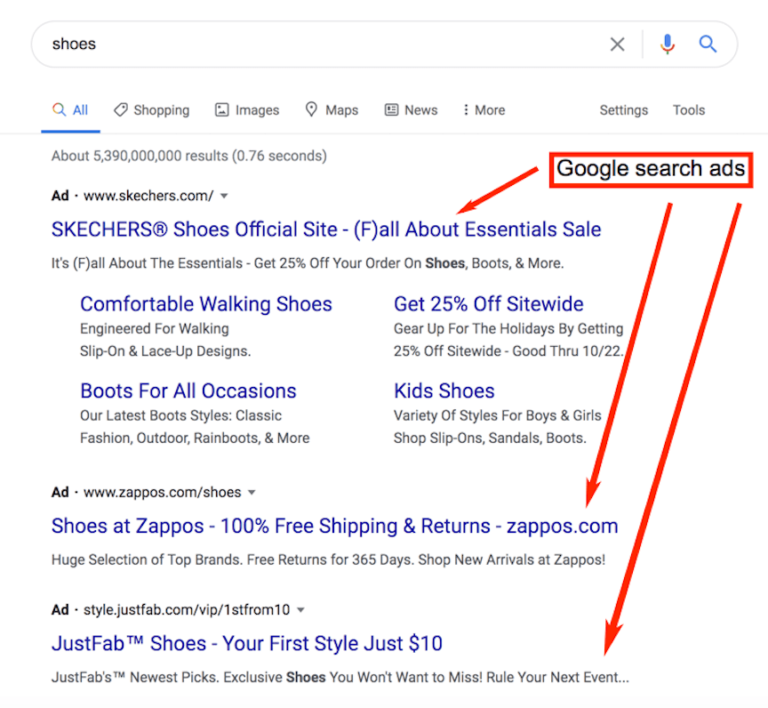Top 8 Features of Google Search Ads You Should Know

1. Keyword Targeting
Advertisers can place bids on particular search phrases that prospective clients use when looking for goods or services thanks to keyword targeting. You can make sure the right people see your adverts by using pertinent keywords. Based on search volume and competition, Google Search Ads offers tools such as Keyword Planner to assist in identifying high-performing keywords.

Google Keyword Planner
2. Ad Extensions
By adding more information in your google search ads and increasing their visibility, ad extensions improve your advertisements. Site links, callouts, structured snippets, and more are examples of these extensions. In addition to that, by providing visitors with additional motivation to interact with your advertisement, they enhance its informativeness and potentially raise click-through rates (CTR).

Types of Ad Extensions:
Sitelink Extensions: Links to specific pages on your website.
Callout Extensions: Additional text highlighting features or benefits.
Structured Snippets: A list of specific aspects of your products or services.
Call Extensions: Add a phone number for direct calls from the ad.
App Extensions: Showcase app download links directly in your ads, driving more installations with ease.
Location Extensions: Display your business address and map link in ads, making it easier for customers to find you.
3. Responsive Search Ads
With responsive google search ads, you can design advertisements that change to display the most pertinent content to users. Also, Google’s machine learning algorithms will experiment with numerous combinations of headlines and descriptions to determine which ones work the best. The performance and relevance of ads are enhanced by this dynamic strategy.
Advantages of Responsive Search Ads:
Flexibility: Automatically adjusts to different devices and screen sizes.
Improved Performance: Optimizes ad combinations based on user engagement.
Time-Saving: Reduces the need for manual A/B testing.
4. Smart Bidding
A collection of automated bid tactics known as “smart bidding” make use of machine learning to maximize conversions or conversion value at every auction. These tactics alter bids in real time based on a variety of indications, including device, location, time of day, and more.
Types of Smart Bidding Strategies:
Target CPA (Cost Per Acquisition): Focuses on getting conversions at a specified cost.
Target ROAS (Return on Ad Spend): Maximizes revenue within a given budget.
Maximize Conversions: Seeks to get as many conversions as possible within the budget.
Enhanced CPC (Cost Per Click): Adjusts bids to maximize conversions.
5. Quality Score
Only Bidding a higher rate for an Ad will not guarantee a higher rank. In addition to that there are other factors that plays a crucial role in the ranking. Google Search Ads utilizes a metric called Quality Score to assess the quality and relevancy of your landing pages, keywords, and advertisements. Better ad placements and reduced expenses may result from a higher Quality Score. Click-through rate (CTR), ad relevancy, and landing page experience are some of the aspects that affect it.


Factors Affecting Quality Score:
CTR: The ratio of clicks to impressions.
Ad Relevance: How closely your ad matches the user’s search intent.
Landing Page Experience: The quality and relevance of the page users land on after clicking the ad.
6. Geographic Targeting
You can show your adverts to people in particular places by using geographic targeting. Ads can be targeted by cities, nations, regions, or even a specific area surrounding a given location. Businesses with a local focus or those looking to target customers in certain markets will find this tool very helpful.
Benefits of Geographic Targeting:
Relevance: Ensures ads are shown to users in your target market.
Customization: Allows for tailored ad messages based on location.
Cost-Efficiency: Avoids spending budget on irrelevant geographic areas.
7. Ad Customizers
With ad customizers, you may change the text of your google search ads in real time according to the user’s search parameters. This can involve presenting various information depending on the user’s location, modifying for time-sensitive promotions, or adding particular keywords. Personalized and highly relevant ad experiences are made possible by ad customizers.
Examples of Ad Customizers:
Countdown Customizers: Show the time remaining for a sale or event.
Keyword Insertion: Automatically insert the user’s search term into the ad text.
Location Customizers: Display location-specific details.
8. Performance Reporting and Analytics
Google Search Ads provides comprehensive reporting and analytics tools to track the performance of your campaigns. You can monitor metrics such as impressions, clicks, CTR, conversions, and ROI. The platform also offers customizable reports and integration with Google Analytics, allowing for in-depth analysis and data-driven decision-making.
Key Performance Metrics:
Impressions: Number of times your ad is shown.
Clicks: Number of times your ad is clicked.
CTR: Ratio of clicks to impressions.
Conversions: Actions taken by users that are valuable to your business.
ROI: Return on investment from your ad spend.
